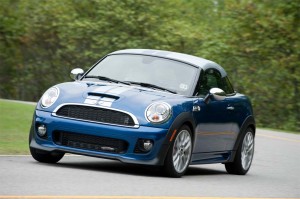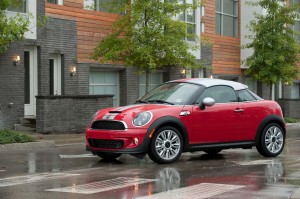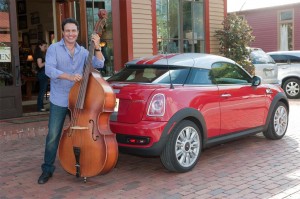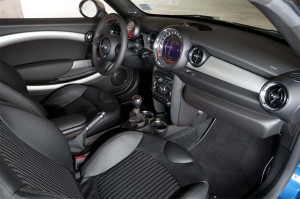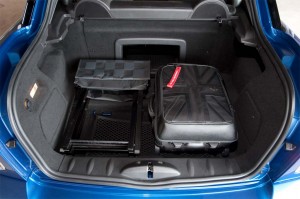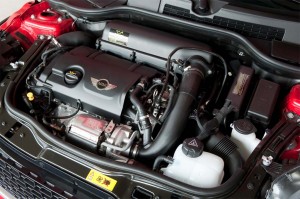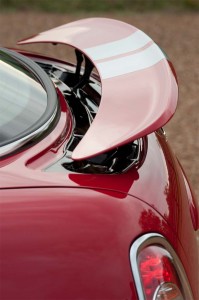Small is big, or so it seems, these days, with all manner of new products, small, smaller and smallest coming to market as buyers put a premium on fuel efficiency. But no brand has done more to change the perception of what a small car can be than Mini, the British marque showing that downsized automobiles can be much, much more than just econoboxes.
And now, just short of a decade after the 2002 launch of the reborn Mini nameplate, the British marque is getting ready to roll out an assortment of new offerings that will bring to seven its model line-up. We had the chance to spend a couple days in Nashville, this month, with the first of the next-gen products, the 2012 Mini Coupe.
The good news is that these latest offerings are not just more of the same. True, many of them are modern takes on models Mini originally offered decades ago. But there’s no confusing the Mini Cooper with the Countryman crossover or even the new Coupe, which Mini’s U.S. chief Jim McDowell suggests is “not like any Mini you’ve ever before.”
Our trip through Nashville and into the surrounding countryside suggests he’s right, wherever we headed, passersby stopping to stare at the first Mini to adopt what designers like to call a “three-box” design. Nor will you confuse the 2012 Mini Coupe with a classic sedan. Then there’s the steeply raked windshield, angled another 13 degrees compared to the standard-issue Mini. But perhaps the most distinctive feature is the new 2-seater’s “helmet roof,” which adds to the Coupe aggressive stance.
Much of what’s been done to the Coupe was fueled by the desire to improve aerodynamics. The more wind-cheating design delivers the dual benefit of increased performance and improve fuel economy – highway mileage climbing to 36 mpg on the base Cooper model.
The Mini Coupe is the fastest car the British maker has ever deliver, the John Cooper Works edition launching from 0 to 60 in just 6.1 seconds, on the way to a 149 mph top speed. Even the base Cooper can turn 60 in an acceptable 8.3 seconds, with a top speed of 127 mph. Meanwhile, the mid-range Cooper S launches in 6.5 seconds and will take you to a ticket-nabbing 142 mph.
The Coupe is actually a wee inch longer than the standard 4-seat Mini, the added length going into the front bumper – also for aero improvement. Meanwhile, engineers came up with an intriguing double real spoiler design to maximize downforce. One of those wings flows out of the helmet roof, the other is a lower pop-up active spoiler that rises at 50 mph and then restracts at 37 mph to improve rear visibility.
That’s certainly helpful. Rear visibility is clearly not the best through the relatively narrow rear window even with the spoiler out of sight.
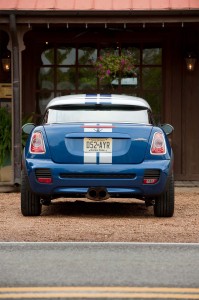
The Mini Coupe incorporates two rear spoilers, one fixed to the "helmet roof," the other popping up when you hit 50 mph.
The 2012 Mini Coupe is also an inch lower than the 4-seater but a creative sculpting of the headliner recovers all but about a third of that so this 6’2” reviewer had no problem sitting inside. Yes, it is very definitely, er, intimate inside, but not quite in the cramped category. There are plenty of storage nooks but, yet again, Mini has opted out on cupholders.
Operating some of the controls, well, that’s another matter, especially the seat recliner, which is in about as awkward a spot as possible without requiring you to actually get out of the car to operate it. Mini has always taken an almost childish pride in the eccentricity of its interior layout, particularly gauges and controls. But you generally get used to the quirky design.
One thing we definitely did not mind was the large navi display Mini now offers as an option. It’s located within the center-mounted speedo cluster. Operating the system is done through an iDrive-like set of controls (recall that Mini is owned by BMW).
That central LCD screen also displays a variety of vehicle controls and the Coupe’s upgraded infotainment system. You can download the Mini Connect app if you own an iPhone and quickly pair it with the car. Among the many features it offers are limited Facebook access, the Pandora music service and the new competitor, Mog radio, which allows you to customize your own sound track from a vast play list.
For those who like to listen to the sound of the car itself, Mini was re-engineered the backfire that performance aficionados liked about the brand’s first offerings.
Speaking of performance, the numbers we mentioned before reflect three powertrain flavors. The base Cooper gets a 1.6-liter inline-four with a variable valve system similar to BMW’s Valvetronic. It makes 121 horsepower and 114 pound-feet of torque. The Cooper S adds a turbocharger with direct injection, bumping the figures to 181 hp and 177 lb-ft. – with brief burst in overboost mode pumping that up to 198 lb-ft. The JCW squeezes out some even more impressive numbers, horsepower jumping to 208, with torque at 192 lb –ft – and 207 in overboost.
The gearbox of choice is a slick and smooth-shifting Getrag six-speed. As you may have seen, Mini is campaigning to increase demand for its manual transmission with a tongue-in-cheek campaign called Manualhood. The maker already has an unusually high “take rate,” with nearly a third of its buyers going for the stick – even on the Countryman crossover. For those who just don’t want to clutch in-clutch out there’s an Aisin 6-speed automatic that, we’ll admit, we found far better than we had anticipated during some spirited driving.
The Cooper S and JCW models feature a Sport setting that, with the Aisin box changes shift settings. It also adjusts both throttle and steering settings.
Even in standard mode we found the Coupe a quick and nimble ball of fun. It does get a little rough around the edges on bumps and potholes – a reality one has to accept in a car with such a short wheelbase. But Mini engineers have done a commendable job of stiffing up the chassis of the new Coupe, which we discovered was borrowed from the Mini Open convertible. There are a number of places the platform has been given added bracing, notably in the crossbeam behind the seats.
Driving through the Tennessee countryside we found little that would knock the Coupe off track short of some seriously rugged pavement. Steering, especially in Sport mode, is quick, responsive and delightfully predictable. Yet the Coupe proved surprisingly forgiving on several occasions when we misjudged some blind corners and had to tighten up quickly.
If there’s any notable flaw it’s the most minor torque steer – and even then we only rarely noticed it on launch, with an occasional appearance during a foot-to-the-floor maneuver in a turn.
When it came to naming the Coupe’s likely competitors Mini officials were almost at a loss. It’s hard to come up with a direct comparison, though names range from the Mazda Miata to the Audi TT.
The fact is that with the 2012 Mini Coupe the British maker has come up with a distinctive and striking alternative that’s bound to get noticed – especially if you get creative with the more than 100 paint, contrasting roof and interior options Mini offers.
At $22,000 for the base Cooper – including $700 in delivery charges – the price tag is reasonable, but certainly not cheap. The Cooper S will push it to $25,300 while the John Cooper Works will set you back $31,900. At that price, the JCW is likely to be the halo, or aspirational model that could bring a lot of young kids into the showroom to look at a nice alternative to the classic Japanese rice rocket.
Mini doesn’t expect to sell many Coupes, and that’s no surprise. Two-seaters aren’t high on the sales charts. But as proof of what the brand can do it’s worth checking out, even if you wind up looking at something else in the maker’s fast-expanding portfolio.

